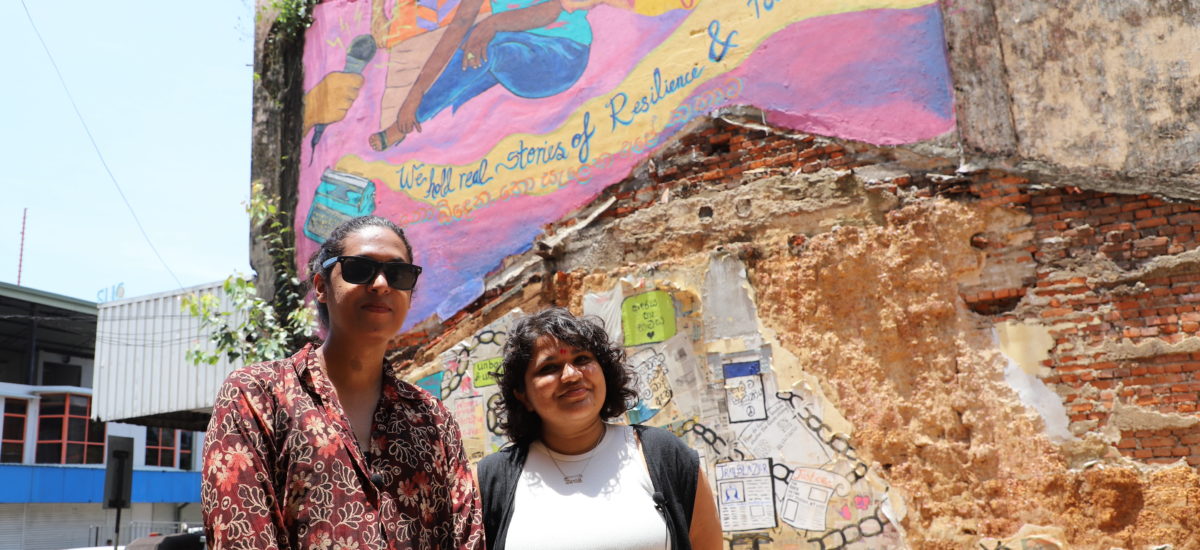Photos by Ama Koralage
Although Sri Lanka has had its fair share of women editors and journalists for many decades, some who ventured into areas of conflict around the country, the image of a journalist is still that of a man.
In order to change this perception and give pioneering women journalists their due recognition for the difficult job they do, the Fearless Collective decided to paint a mural on the wall of the Rio cinema in Union Place featuring three women journalists from different backgrounds and ethnicities.
“We realise that a lot of women in this profession have had extremely difficult careers and because of that we wanted to recognise them for their resilience as well as their power. This mural is just a representation of that,” said Minal Wickrematunge who, along with Vicky Sahjahan, is an ambassador for the Fearless Collective in Sri Lanka.
“We are living in a male dominated society so a lot of the images on the streets are of male politicians. We want to change this by representing women as leaders. These journalists are leaders who have become vessels for their communities. What we wanted to do was to turn the mic towards them and ask them their stories. Nobody really asks a journalist about their story and why they came into this profession,” she pointed out.
The Fearless Collective says that it “turns up at moments of national fear and trauma and makes space for collective imagination, creative thinking, social discourse and beauty amidst crisis and emergency.” It has been at the frontline of crucial moments of resistance in South Asia, including at the Gotagogama protest site in June 2022.
It has created over 40 public monuments in 16 countries, working with communities most invisible or marginalized including Muslim and Dalit women in India, indigenous communities in Brazil and North America, communities affected by gang violence in Pakistan, Syrian and Palestinian refugees in Lebanon and queer communities in Tunisia and Indonesia.
“When I was given the chance to choose a community I wanted to work with, I knew it was journalists because I come from a family of media representatives and journalists; I wanted to do something that was a nod towards that,” said Minal.
For Vicky, as a trans woman, the Fearless Collective gave her the confidence and freedom to be who she was and be part of a collective where people understood her creativity and the way she worked. “Being fearless is about how fearlessly you accept yourself and how you are ready to fight the world in different ways on your own journey, fighting all kinds of oppression and all kinds of odds,” Vicky said.
Each mural by the Fearless Collective speaks to a broader theme of resonance and importance in the Global South. At present, it focuses on three campaigns: gender and environmental justice, the gender spectrum and migration and conflict.
Art in Colombo is confined to small galleries that are not comfortable spaces for many people, being the privilege of the elite. Murals, however, are accessible to all. “Murals are a way to connect to people through visuals irrespective of language. You could be at the bus stand opposite and admire the beauty of this mural…Murals are a way of bringing people together. People come together to look at this mural representing three different women from different backgrounds and ethnicities,” Minal said.
The process of creating the mural begins with a workshop where the artists listen to the women’s stories, which are then transformed into the art work. One woman who shared her the story of her life and work was Furkanbee Ifthikar, who has been a journalist for many years, fighting against discrimination and prejudice. “Although her face is not shown, it is her spirit that we have imbibed into the mural after she shared her story about being a Muslim woman and being a pioneering journalist, “ Vicky said.
“The mural creates a medium for discussion but you don’t need language to understand it. They were not here many years ago but now murals are an easy way to reach people,” said Furkanbee.
Click on the link below to watch the full interview with Minal Wickrematunge and Vicky Sahjahan.
Please click on images





